Technical 2
The Cinematography of The Third Act

"We worked pretty hard to achieve the look of The Third Act " said DP Terry Lennox. "That's not to say that it will be to everyone's taste, but I think we served the material. I see so many shows where everything is so slick and perfectly lit that it doesn't look real. When I see shots like that my mind starts wandering from the characters and plot to figuring out how many generator trucks they needed to do the lighting. TTA is a story that looks at two people warts and all. For much of the story a smooth, pretty looks wasn't what we were after. This is not to say we just went in and started shooting. We actually did some pretty serious testing and recon for all the scenes and locations.
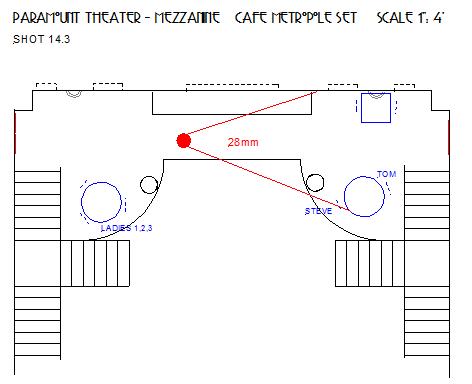
CAD Drawing - Plan view of Cafe Metropole set
"For most locations, prep started by measuring the space and taking stills of the overall area as well as the details we wanted to include. Then we used the measurements to develop CAD drawings for each location. The stills were used to generate our shot framing and were often painted with elements we wanted in the set.
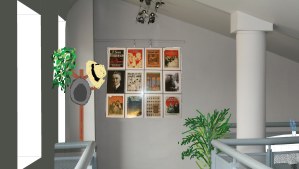
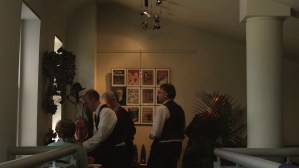
Painted storyboard (LEFT) and frame grab (RIGHT)
"Since TTA was going to be shot on a very small budget it was important that we arrived on set every morning knowing with fair precision what lenses we would be using, for example. This detailed pre-production approach saved us a lot of time, especially in the scenes inside The Red Bridge Playhouse. It also allowed us to figure out our lighting plan and only bring the equipment we needed. With the CAD layouts and storyboards, on the day, then, it felt like we had already shot the scene three times so we had a comfort level.
"In keeping with the naturalistic lighting plan, our lighting kit consisted entirely of two 1K focusable lamps with 24" x 36" soft boxes, a dozen little fixtures built with 60W globes and specialty bulbs, and three LED panels that I built before LED panels were widely available. For the theater scenes we did use follow spots, ellipsoidals, and other stage lights but that was more for stage effect than lighting. In one of my favorite shots, the "Reprise" shot from the end of the film, all we used were the two 1Ks raking the curtains and a single follow spot.
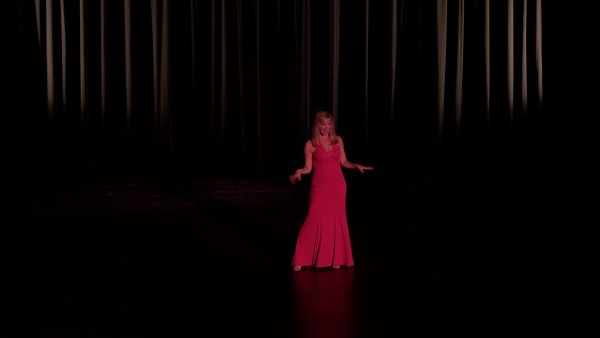
The Reprise
"We tried to keep things very simple and logical. For example, except for one brief interior. we shot day-for-day and night-for-night. If the scene was supposed to happen at 10AM, we shot it at 10AM. For the night EXT of Tom entering the bar, rather than parking a Musco truck down the block and raking the front of the building so we could read all the signs, we just drove a van down the street and let the van's headlights do the job. It's a much more natural look. That you can't read the detail on the front of the building makes no difference; as soon as the door opens and you see the beer sign - which we did light, by the way - you know exactly what's going on.
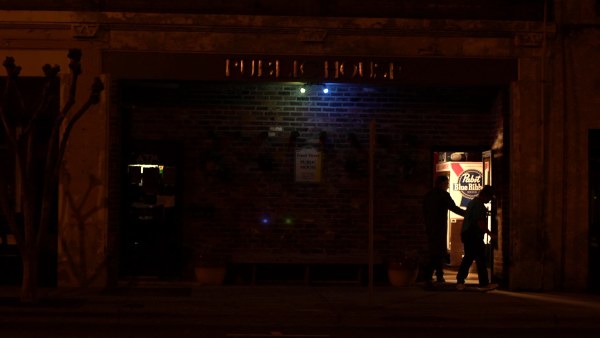
The Bar
"I'm sure there are situations on pictures with a million extras where it becomes cost-effective to tap a power station and run a gigawatt's worth of lights to extend your shooting day. But we didn't have to do that; if we ran out of light we shot scenes that were supposed to happen at night.
"I read something recently by someone shooting a low budget film that needed to shoot a scene in the woods in moonlight. When I saw that I thought this was my chance to rub elbows with the big boys because we had shot a couple of scenes like that. But again I was left scratching my head. With their "low budget" they built their woods on a sound stage, hauled in 400 trees, landscaped it and used about 100K of lights. We just waited for a full moon, went out into the woods and shot it.
"If the shot was to be made inside a moving car, we put the camera on a mount inside the car and the actor drove. The operator was pretzeled into the boot but it's real footage. When I see in-car shots where the car is obviously a foot above the road on a trailer and the driver is sawing away at the steering wheel, obviously not really driving, I cringe.
"TTA is a story with a dark undertone and it was important to carry that through the photography. The therapy scenes are dark. The theater scenes are dark. A good deal of the action takes place at night on the street or in a car. I wanted a very Gordon Willis approach to lighting and framing. When we do see light we wanted it to almost make the viewer blink. So we often let the highlights approach burn-out.
"Another consideration of the story is Katie's fantasy sequences when she imagines herself on stage singing Tom's songs. This called for another sort of look to set it apart from Katie's reality. I'm always amazed when I read that someone thought it was imperative they shoot on the absolute sharpest (and most expensive) lenses - and then stacked diffusion in front of the lens or fiddled the footage in post to take out "the digital look." We just used softer lenses. The Canon FDs were perfect for us. They're a little more prone to flare than lenses with the very latest construction and coatings but that was what we were after. Swinging the dolly around behind Katie in the "Intro" shot and looking into that blue-gelled follow spot with a #2 Smoque filter on our 35mm f2.0 FD we got a very nice soft flare that immediately tells the viewer that this is not business as usual.
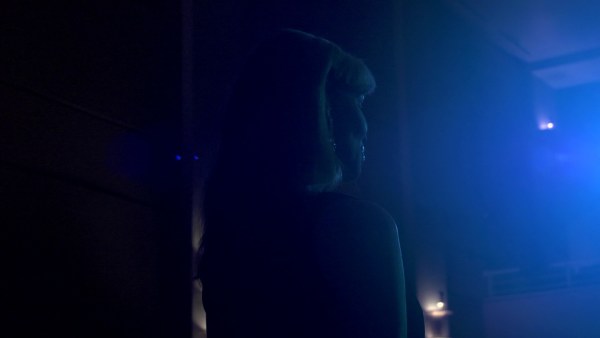
The "Intro" title sequence
"Focus distances on TTA ranged from 15 inches to 350 feet so we wound up using every lens in our kit of FDs (20, 24, 28, 35, 50, 85, 135, 200, 300, 35-105mm) except for the 300mm. For the run-and-gun outdoor montages we put on the excellent 35-105mm F3.5 zoom and pretty much left it on, using it as a variable prime. It gave us a nice flare when we wanted it. The 20mm F2.8 was also a workhorse as it let us get proscenium shots in the theater without having to knock out the back wall. A lot of the close-ups I did with the 50mm F1.8. And the 200mm 2.8 was pressed into service more often than expected. We accentuated the softness in the appropriate scenes by using wider shutter angles for motion blur. Katie's first therapy scenes were shot with a 360 degree shutter. "Normal" was defined as 140 degrees. And when we wanted to sharpen things up for emphasis we'd go to 72 or 35. For one of the montage sequences we overcranked at 36 fps. We tested 40 and 48 but they seemed like obvious and deliberate slow motion whereas 36 just seemed dreamy.
"Another montage of shots concerned Katie's memories of happier times. We wanted to keep the color pretty saturated in these shots so we again used the #2 Smoque filter to soften them up and shot at golden hour, which gave us even more softness. Lately it seems like everyone wants to create effects like this in post but to me that doesn't look natural. We also shot about 5000 stills for this part of the story which were played back at 2 to 6 fps after being cropped and manipulated with different film looks, Hipstamatic-style.
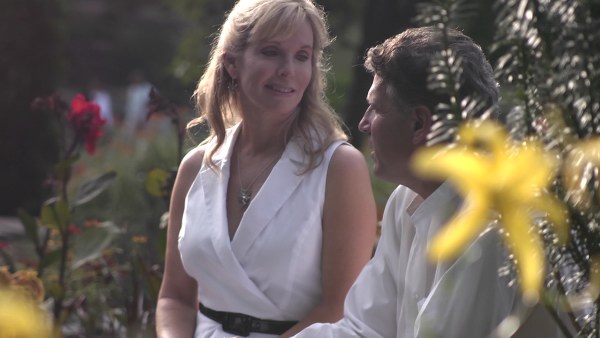
The "Montage" sequence
"On set we would dial in an approximate look but we saved real color correction for post. With a tiny crew the last thing we needed to try to do was fine tune the color correction on set.
"We shot close-ups slightly flatter than normal, keeping in mind we would be adding some contrast in post, along with a little desaturation in the Therapy scenes. I used an Obie light a couple of times on Elizabeth and that was all."
Lennox rated the Panasonic AF-100 at 320 ASA and shot 90% of the film at that speed with the remainder at 500 ASA. "The AF-100 isn't going to give you the low light performance of an Alexa but for our purposes it worked very well. We achieved good solid blacks and a surprising depth in the whites, especially in the shots where we had the actors wardrobed in white and were almost begging for burnout. We did pick up a little noise in the mid-tones in a few shots in the theater, especially on the beige walls. We applied some de-noising software and it cleaned right up without going soft."
Copyright Neill Fleeman 2012